Abstract
The cooling system is an important subsystem of an internal combustion engine, which plays a vital role in the engine’s dynamical characteristic, the fuel economy, and emission output performance at each speed and load. This paper proposes an economical and precise model for an electric cooling system, including the modeling of engine heat rejection, water jacket temperature, and other parts of the cooling system. This model ensures that the engine operates precisely at the designated temperature and the total power consumption of the cooling system takes the minimum value at some power proportion of fan and pump. Speed maps for the cooling fan and pump at different speeds and loads of engine are predicted, which can be stored in the electronic control unit (ECU). This model was validated on a single-cylinder diesel engine, called the DK32. Furthermore, it was used to tune the temperature of the water jacket precisely. The results show that in the common use case, the electric cooling system can save the power of 255 W in contrast with the mechanical cooling system, which is about 1.9% of the engine’s power output. In addition, the validation results of the DK32 engine meet the non-road mobile machinery China-IV emission standards.
1. Introduction
The cooling system performance is important for engine performance [1]. The purpose of the cooling is to maintain the temperature of the engine components and the temperature gradient at appropriate levels (for example, at 180–200 °C for aluminum alloys and 380 °C for cast iron). At present, most cooling systems are designed with mechanical fans, water pumps, and max thermostats. Since the fan and water pump are driven by the crankshaft at fixed speed ratios, their speed changes with that of the crankshaft but it does not change with the engine load which results in the problems of undercooling or overcooling [2].
Undercooled engines may suffer from several problems, including loss of material strength, high thermal strain, lubricant oil degradation, overheating and abrasion of the power cylinder components, heating the intake air, and lower volumetric efficiency. At part loads or in cold climates, the engine coolant can become excessively cold, which adversely affects engine combustion and performance. Overcooled engines may worsen the combustion and fuel economy and result in excessive heat rejection, high wear of piston rings and liners, and excessive friction and noise. Both overcooling and undercooling have adverse effects on engine performance. Undercooling, which results in damage to the engine, should be avoided. Brace et al. [3] estimated that engines with mechanical cooling system are overcooled for about 95% of their operating time.
Mechanical cooling systems (the speed of the fan or water pump connected to the crankshaft) are not capable of regulating the temperature precisely [4]; therefore, they should be decoupled from the crankshaft so the speed can be controlled independently. The fan, water pump, and thermostat can be controlled electrically and can be regulated up by an electronic control unit (ECU); this controllable system has potentiality to realize the target temperature. Recently, many researchers have investigated this topic. Allen et al. [5] discovered the benefits of such systems. In the past two decades, great progress has been made with regard to precise cooling [6], cooling mechanisms [7], engine cooling system design and optimization by Burke et al. [8], and cooling system simulations by Haghighat et al. and Bova et al. [9,10].
As the demand for higher fuel economy and stricter emission regulations has increased [11,12,13], the engine operating parameters are falling into a smaller range, which highly depends on the speed, load, atmospheric parameters, and other factors. Therefore, the operating parameters should be tuned precisely [2,14,15]. For example, the fuel injection timing, injection pressure, and pressure ratio of the supercharger should be controlled by the ECU of engine. In this study, we focus on the control of the engine coolant temperature. Many studies [16,17,18,19,20] have examined this topic in passenger and commercial vehicle engines, some of which were equipped with an electric cooling system. In general, this system utilizes feedback control strategies, including the electric pump, electric fan, electric thermostat, and controllers as well as various sensors. The system is complex, costly, and easily fails in harsh environments.
Single-cylinder diesel engines and applications in tractors are widely used in underdeveloped and developing countries. Statistics have shown that more than 12 million single-cylinder diesel engines are used in China and Southeast Asia. These engines are commonly operated in poor working environments and their cost should be as low as possible. In fact, in order to save costs, manufacturers have not comprehensively updated their product in the past 50 years, even though the emission characteristics of these engines are lower than the EPA Tier 1 [21].
For these reasons, the electric cooling systems used in commercial vehicles cannot be directly applied to single-cylinder engines. Therefore, innovations are required, especially with regard to the cost-effective cooling systems. In this paper, we propose an economical and precise model for an electric cooling system; the model is validated and applied to an electronically controlled single-cylinder engine called the DK32 [22] (Figure 1). The engine is equipped with an electronic unit pump and 4-valve in the valve train, among other components. The key parameters of the engine are as follows: bore and stroke = 113 mm × 140 mm, rated power = 23.5 kW @ 2600 rpm, max torque = 100 N·m @ 1500 rpm, minimum brake-specific fuel consumption (BSFC) is 199 g/(kW·h). Most importantly, the engine meets the China-IV emission standards [23], which set limits on particulate matter (PM) < 0.6 g/(kW·h), CO < 5.5 g/(kW·h) and CH + NOx < 7.5 g/(kW·h). In this study, we demonstrate that the proposed economical and precise model of the electric cooling system without a thermostat is capable of precisely regulating the coolant temperature; this is an important aspect of ensuring good engine performance.
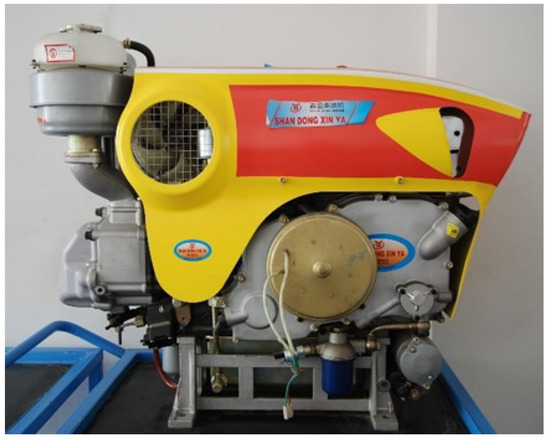
Figure 1.
The DK32 engine designed by Tsinghua University.
The lumped-parameter model [24] is a commonly used model for cooling systems and is based on several assumptions that are too imprecise for a high-level engine. In general, there are several interactions between the cooling systems and the engine performances. Firstly, the cooling system consumes engine power, which is the direct effect. Secondly, the cooling system influences the temperature field of the engine body and further lubrication and friction, combustion, engine heat rejection, and charge density and temperature, which are the indirect effects. Many studies have been conducted on these separate issues but the universal relationship between the coolant temperature and the engine performance has yet to be determined; thus, in this study, we treat the engine as a ‘black box’. We measure the coolant temperature and heat rejection in an engine bench system when the performance of engine is satisfactory then tune the cooling system according to the measurement of coolant temperature and heat rejection to obtain the expected engine performances. It is well known that an engine is a multi-variable complex system; other variables also need to be tuned according to the relevant data.
The remainder of this paper is organized as follows. Section 2 describes the proposed mathematical model of the cooling system based on the experimental data of heat rejection and target temperature of the water jacket. Section 3 describes the model solutions to determine the speed of the fan and pump at different speeds and loads under the constraints of minimal total power consumption, and Section 4 examines the problem of overcooling and discusses the benefits of an electric cooling system. The final section concludes the paper.
2. Model of the Cooling System
The cooling system model includes the models of the radiator, fan, pump, engine heat rejection, and the target temperature of the water jacket. The models are described in the following subsections.
2.1. Heat Rejection Model of Engine
The heat rejection Q from the engine to the coolant can be obtained from heat balance experiments, simulations [2,25], which are common-used method in engine design to verify the thermal efficiency and thermal distribution of the engine. The collected data is used to design the cooling system of engine and to improve the engine performance. Q depends mainly on the two variables, which are the speed of engine n and the ratio of the load . In this study, each of them was divided into 10 intervals; the heat rejection depicted in Figure 2 is obtained from the heat balance experiment for the different pair [26] and is interpolated into a continuous function as defined in Equation (1):
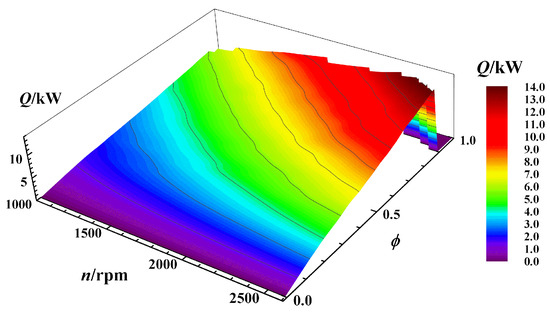
Figure 2.
Map of heat rejection of the DK32 engine.
2.2. Target Temperature of the Water Jacket
The temperature of the water jacket affects the fuel efficiency, emissions [27,28], noise, vibration, and harshness [29] of engine by three main factors: frictional losses of the engine, auxiliary power to operate the cooling system, combustion-chamber boundary conditions, and charge density and temperature. Thus the target temperature of the water jacket can be obtained using engine performance experiments [2]. That is, for different pair , we determine the temperature of water jacket that is compatible with the desired fuel efficiency and emission as well as other requirements. If these requirements cannot be achieved, the designers must tune other parameters, such as fuel injection timing, injection pressure, and so on. In this way, we get the target temperature of the water jacket shown in Figure 3, then interpolated into a continuous function as defined in Equation (2):
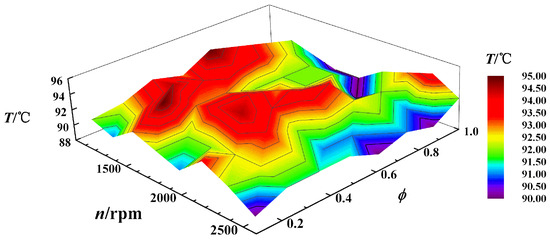
Figure 3.
Map of target temperature of the water jacket in the DK32 engine.
2.3. Model of the Radiator
This subsection describes the mathematical model of the radiator based on experimental data or calculations [30,31]. The heat dissipation potential of a radiator depends on the volumetric flow rate of air , the volumetric flow rate of water , and the temperature difference between the air and water measured at the inlet of the radiator. One can divide every variable into several intervals and measure the heat exchange of the radiator for each combination. The orthogonal experimental design method is used to reduce the number of experiments. The measured values of the three variables are used to fit a continuous polynomial function. Assuming that heat exchange will not occur when or , we have
where these coefficients are ; the fitting error is in the range of [−4.7%, 4.8%]. The solution to the mathematical model described in Section ‘Model solutions’ indicates that a simple form of , such as in Equation (3), reduces the amount of time used in the numerical calculations; however, this process is not necessary. One can interpolate the experimental data to obtain greater accuracy.
Since there is resistance from the conductor and radiator, the pressure is lowered when water and air pass through the cooling system. The values of the decrease in pressure, and depend on the volumetric flow rate of air and water and are measured in the experiments. and are fit as a function of , , respectively,
The experimental data and the fitted functions are shown in Figure 4 and Figure 5, respectively, where in the subsequent graphics discrete points stand for experimental data and segments stand for interpolation.
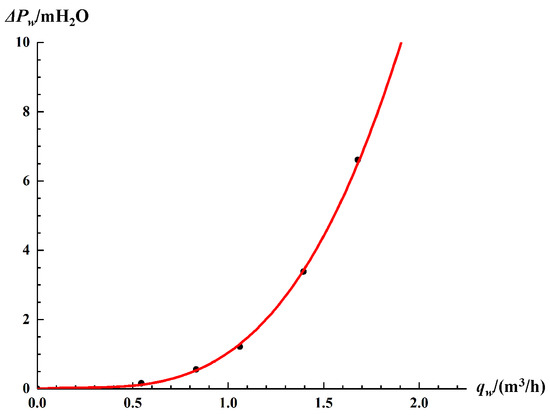
Figure 4.
of the cooling system.
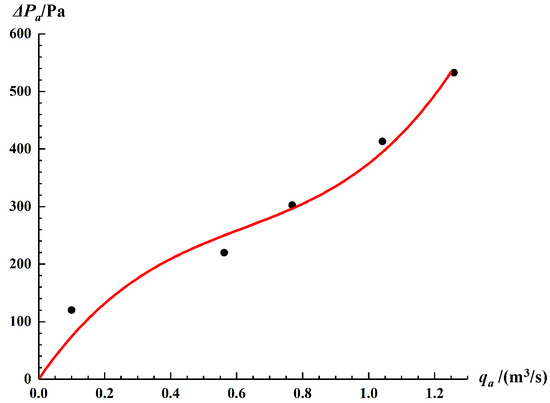
Figure 5.
of the cooling system.
2.4. Model of the Fan and Pump
Even if empirical relations exist for the performance of the fan and pump, some corrections are required for precise cooling. We get the performance by experiment at several typical rotating speed, then fit into continuous functions, Equations (6) and (7), as shown graphically in Figure 6, Figure 7, Figure 8 and Figure 9, and
where the subscript are short for pump and fan, respectively; are stand for the rotating speed with a unit of rpm, volumetric flow rate, pressure difference and power required, respectively.
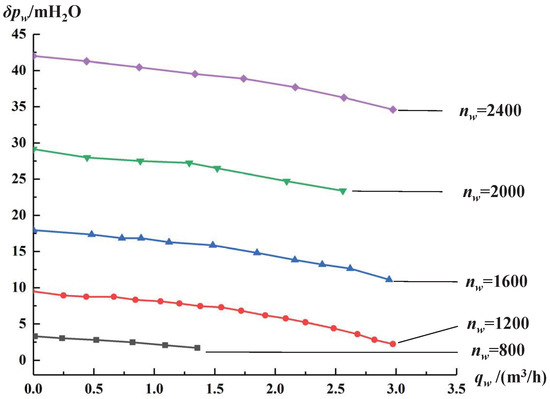
Figure 6.
Pressure characteristics of the water pump.

Figure 7.
Power characteristics of the water pump.
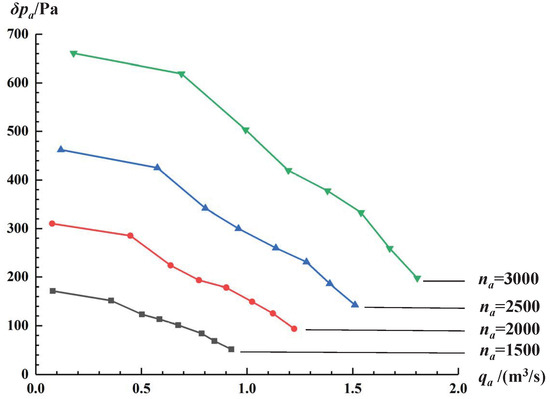
Figure 8.
Pressure characteristics of the fan.
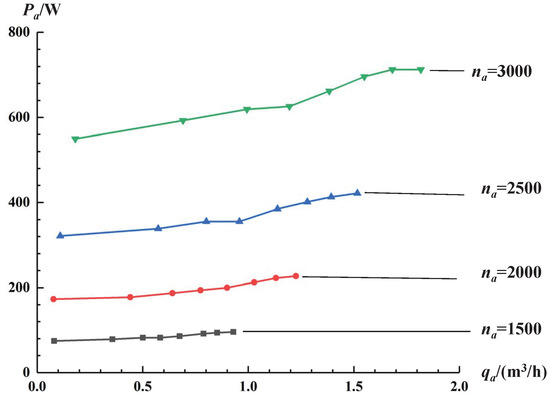
Figure 9.
Power characteristics of the fan.
3. Model Solutions
After establishing the mathematical models of the electric cooling system and the parts in the previous section, this section describes the model solutions, that is, find the output parameters once is given. To illustrate the benefits of this model, a model of a mechanical cooling system is also solved. The two cooling systems have the same types of radiators, fans, and water pumps but there are different drives.
3.1. Electric Cooling Model Solution
For a steady case, the solution steps for the model of the electric cooling system are as follows:
- Calculating the heat dissipation of the radiator: Plug in Equations (8) and (9) into Equation (3) to obtain,By assuming that the heat rejection in Equation (1) is equal to the heat dissipation of the radiator, one obtains:Recall that , where is the target temperature of the water jacket and is the atmospheric temperature. In Equation (11), only are unknown; thus, the fan speed can be expressed as a function of the water pump speed ,
- Obtaining and the total power consumption P: P can be written as: and combined Equation (12), P can be rewritten as a single-variable function of , thus minimizing the total power consumption; therefore, P can be written as:Using this equation, and then can be solved, where P has a minimum value. At this point, the solution of the electric cooling model is complete.
3.2. Mechanical Cooling Model Solution
The first step in solving the mechanical cooling model is the same as in the electric cooling model. Since the axes of the fan and water pump are connected to the crankshaft with fixed speed ratios of , respectively, one obtains:
From Equation (14), of the mechanical cooling system is a function of and depends on the parameter . Thus, it may be larger or smaller than the heat rejection of the engine for given values of and . To avoid undercooling the engine, in Equation (14) should be larger than Q in Equation (1) for all , even in the harshest case. For the DK32 engine, the harshest case is the highest atmospheric temperature 40 °C. Theoretically, this can be achieved as follows: in Equation (14) and Q in Equation (1) are functions of ; thus, they can be plotted in the domain to ensure that the surface is just above Q. If this is not possible, then the cooling system must be improved. For the DK32 engine, the values are plotted in Figure 10: when and 40 °C. In the right of Figure 10, the two small figures illustrate that denoted by gray surface is always bigger than Q denoted by the colorful surface.
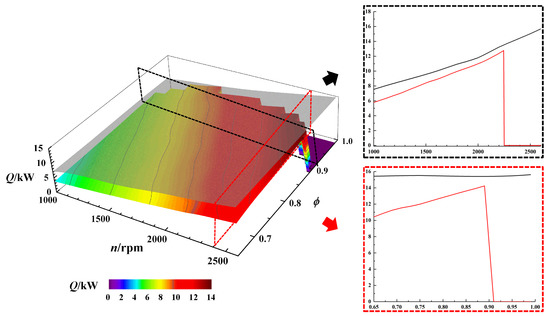
Figure 10.
The plot ensures that the cooling system works well in all cases. The gray surface representing in Equation (14) is just above the colorful surface, which represents the heat rejection Q of the engine.
There are several differences in solving the models of the two different cooling systems.
(a). The heat rejection in the mechanical cooling system does not match Q of the engine in Equation (1) for any . That is, in some cases, the cooling system extracts more heat than required; in other cases, it may extract less.
(b). The approach to calculating the total power consumption differs for the two cooling systems. These differences are discussed in the next section.
4. Results and Discussion
In this section, we compare the total power consumption of the two cooling systems and describe the performance of the DK32 engine, equipped with the electric cooling system.
Several typical loads are chosen to calculate the power consumptions of the two cooling systems, that is and . Here, F represents a full load. The power consumption curves for different loads at different engine speeds are shown in Figure 11. The results indicate that power consumption of a mechanical cooling system increases with the engine speed and is the same for all . The power consumption of the electric cooling system increases with the engine speed and is lower for lower values of as expected; the power consumption is lower for the electric cooling system than the mechanical cooling system. In the case of , the power consumption of the electrical cooling system is 300 W, 213 W and 117 W for 40 °C, 35 °C, and 30 °C, respectively, whereas the power consumption of the mechanical cooling system is about 680 W. This trend becomes more apparent as decreases, such as in the case of . In the common use case, this occurs in the region of the minimum BSFC and C, where the total power consumptions of the electric and mechanical one are 35 W and 290 W, respectively. Therefore, the power saving of using the electric cooling system is 255 W, that is, the direct benefit of the electric cooling system is about 1.9% of the engine’s power output.
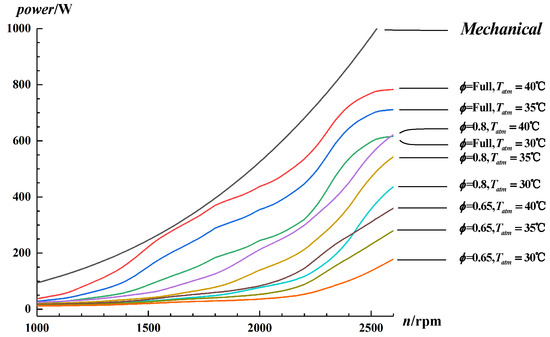
Figure 11.
The total power consumption for several typical loads.
The indirect benefit of the electric cooling system is much higher than the direct benefit. As mentioned above, in the common use case, the electric cooling system consumes 35 W output power of the engine and brings out about 7.2 kW heat rejection and ensures the target temperature of the coolant. However, in the mechanical cooling system, the excess power consumption drives the fan and water pump at excessive high speeds, resulting in overcooling of coolant and engine and thereby increasing the heat rejection of the engine to the ambient environment. The experimental data show that the mechanical cooling system results in 8.3 kW of heat rejection and the minimum BSFC is 211 g/(kW·h). Thus, under a part load, the mechanical cooling system uses a small proportion of the available engine power to incur high heat losses, which results in inefficiencies at part load of the engine-power curve, for details please refer to [2].
The amounts of exhaust pollutants of the DK32 engine are markedly different for the two kinds of cooling systems. The test results obtained by the National Automobile Quality Supervision and Test Center are listed in Table 1. It is evident that the engine with the electric cooling system meets the China-IV emission standard [23], whereas the engine with the mechanical cooling systems does not meet the standard because the CH + NOx value exceeds the limit. However, this engine can not meet EPA 3 standard because of the CH + NOx value. Additional technical measures, such as turbocharging or increasing fuel injection pressure or after-treatment, can improve the situation.

Table 1.
The test results of exhaust pollutants and limits of emission standards [21,23], with a unit of g/(kW·h).
Based on this mathematical model, the fan and water pump speeds can be predicted. For example, for C, the speeds are shown in Figure 12 and Figure 13. The speed data can be stored in the ECU of the engine and are used to control the fan and water pump speed to ensure that the engine operates at the target temperature.
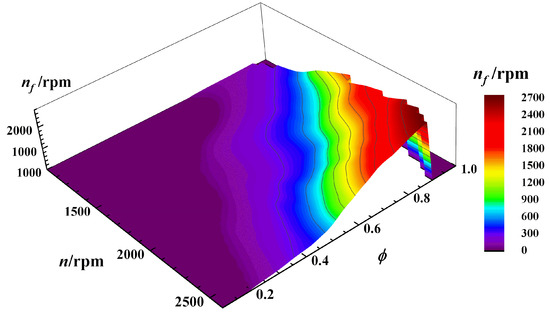
Figure 12.
Speed map of fan for 35 °C.
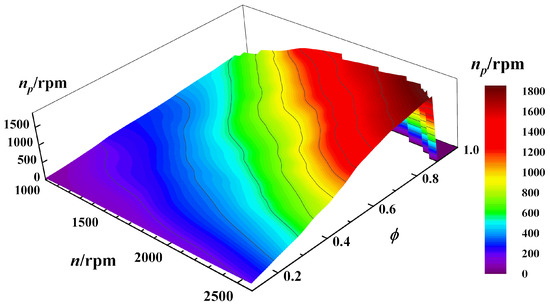
Figure 13.
Speed map of water pump for 35 °C.
5. Conclusions
In this study, an economical and precise model for an electric cooling system of a single-cylinder diesel engine was established and the submodels of all the components were described in detail. A map of the heat rejection of the engine was created from the heat balance experiments. The cooling temperature can be tuned precisely and the total power consumption of the cooling system was minimized by optimizing the power proportion of the fan and pump.
In the model, the engine heat rejection was measured in an engine bench test at steady conditions, which was assumed to be independent of the atmospheric temperature. To obtain higher accuracy, empirical relations were required to correct the data; atmosphere temperature can be used as an additional variable. The results indicated that this model performs well.
The model was validated using the DK32 single-cylinder diesel engine. It showed that power saving of 1.9% can be obtained in the common use case. The minimum BSFC of the engine was 199 g/(kW·h), and the engine meets the non-road mobile machinery China-IV emissions standards. Additional technical measures could further improve the emission preformance so as to meet the EPA 3 standard. The proposed model can be used in designing of single-cylinder engines. Even without the thermostat, the non-road mobile machinery emission standards were met. Therefore, the model was economical and suitable for low-cost agricultural machinery. It can be expanded to include the effect of thermostats for further improvement and the transient effect can also be taken into consideration, thereby improving the transient control performance to meet future emission standards.
Author Contributions
Conceptualization, Z.X.; methodology, Z.X.; software, A.W., Z.X. and Z.L.; validation, Z.L. and Z.X.; formal analysis, Z.X.; investigation, Z.X. and Z.L.; resources, Z.X.; data curation, A.W. and Z.X.; writing—original draft preparation, Z.X.; writing—review and editing, Z.L. and Z.X.; visualization, Z.L., Z.X. and A.W.; supervision, Z.X.; project administration, Z.X. All authors have read and agreed to the published version of the manuscript.
Funding
This research received no external funding.
Institutional Review Board Statement
Not applicable.
Informed Consent Statement
Not applicable.
Data Availability Statement
The data presented in this study are available on request from the corresponding author.
Conflicts of Interest
The authors declare no conflict of interest.
References
- Liang, Y.; Yu, Z.; Li, W. A waste heat-driven cooling system based on combined organic Rankine and vapour compression refrigeration cycles. Appl. Sci. 2019, 9, 4242. [Google Scholar] [CrossRef] [Green Version]
- Xin, Q. Diesel Engine System Design; Elsevier: Amsterdam, The Netherlands, 2011. [Google Scholar]
- Brace, C.J.; Hawley, G.; Akehurst, S.; Piddock, M.; Pegg, I. Cooling system improvements-assessing the effects on emissions and fuel economy. Proc. Inst. Mech. Eng. Part D J. Automob. Eng. 2008, 222, 579–591. [Google Scholar] [CrossRef]
- Pang, H.; Brace, C. Review of engine cooling technologies for modern engines. Proc. Inst. Mech. Eng. Part D J. Automob. Eng. 2004, 218, 1209–1215. [Google Scholar] [CrossRef]
- Allen, D.; Lasecki, M. Thermal Management Evolution and Controlled Coolant Flow; SAE Technical Paper 2001-01-1732; SAE: Warrendale, PA, USA, 2001. [Google Scholar] [CrossRef]
- Wang, Y.; Gao, Q.; Zhang, T.; Wang, G.; Jiang, Z.; Li, Y. Advances in Integrated Vehicle Thermal Management and Numerical Simulation. Energies 2017, 10, 1636. [Google Scholar] [CrossRef]
- Katta, K.; Kim, M.; Taggett, M. Exhaust Heat Co-Generation System Using Phase Change Cooling for Heavy Duty Vehicles; SAE Technical Paper 2008-01-2450; SAE: Warrendale, PA, USA, 2008. [Google Scholar] [CrossRef]
- Burke, R.; Brace, C.; Hawley, J.; Pegg, I. Review of the systems analysis of interactions between the thermal, lubricant, and combustion processes of diesel engines. Proc. Inst. Mech. Eng. Part D J. Automob. Eng. 2010, 224, 681–704. [Google Scholar] [CrossRef]
- Haghighat, A.K.; Roumi, S.; Madani, N.; Bahmanpour, D.; Olsen, M.G. An intelligent cooling system and control model for improved engine thermal management. Appl. Therm. Eng. 2018, 128, 253–263. [Google Scholar] [CrossRef]
- Bova, S.; Castiglione, T.; Piccione, R.; Pizzonia, F. A dynamic nucleate-boiling model for CO2 reduction in internal combustion engines. Appl. Energy 2015, 143, 271–282. [Google Scholar] [CrossRef]
- Kim, H.Y.; Ge, J.C.; Choi, N.J. Effects of ethanol–diesel on the combustion and emissions from a diesel engine at a low idle speed. Appl. Sci. 2020, 10, 4153. [Google Scholar] [CrossRef]
- Benajes, J.; García, A.; Monsalve-Serrano, J.; Boronat, V. Dual-fuel combustion for future clean and efficient compression ignition engines. Appl. Sci. 2017, 7, 36. [Google Scholar] [CrossRef]
- Valencia, G.; Duarte, J.; Isaza-Roldan, C. Thermoeconomic analysis of different exhaust waste-heat recovery systems for natural gas engine based on ORC. Appl. Sci. 2019, 9, 4017. [Google Scholar] [CrossRef] [Green Version]
- Piano, A.; Millo, F.; Sapio, F.; Pesce, F.C. Multi-Objective Optimization of Fuel Injection Pattern for a Light Duty Diesel Engine through Numerical Simulation. SAE Int. J. Engines 2018, 11, 1093–1107. [Google Scholar] [CrossRef]
- Naruemon, I.; Liu, L.; Liu, D.; Ma, X.; Nishida, K. An Analysis on the Effects of the Fuel Injection Rate Shape of the Diesel Spray Mixing Process Using a Numerical Simulation. Appl. Sci. 2020, 10, 4983. [Google Scholar] [CrossRef]
- Chanfreau, M.; Gessier, B.; Farkh, A.; Geels, P.Y. The Need for an Electrical Water Valve in a THErmal Management Intelligent System (ThemisTM); SAE Technical Paper 2003-01-0274; SAE: Warrendale, PA, USA, 2003. [Google Scholar] [CrossRef]
- Pang, H.H.; Brace, C.; Akehurst, S. Potential of a Controllable Engine Cooling System to Reduce NOx Emissions in Diesel Engines; SAE Technical Paper 2004-01-0054; SAE: Warrendale, PA, USA, 2004. [Google Scholar] [CrossRef]
- Ogawa, H.; Raihan, K.A.; Raihanl, K.A.; IIizuka, K.I.; Miyamoto, N. Cycle-to-cycle transient characteristics of diesel emissions during starting. SAE Trans. 1999, 1999, 1450–1456. [Google Scholar]
- Torregrosa, A.; Olmeda, P.; Martin, J.; Degraeuwe, B. Experiments on the influence of inlet charge and coolant temperature on performance and emissions of a DI Diesel engine. Exp. Therm. Fluid Sci. 2006, 30, 633–641. [Google Scholar] [CrossRef]
- Sun, Y.; Dong, W.; Yu, X. Effects of coolant temperature coupled with controlling strategies on particulate number emissions in GDI engine under idle stage. Fuel 2018, 225, 1–9. [Google Scholar] [CrossRef]
- US-EPA. Nonroad Model (Nonroad Engines, Equipment, and Vehicles); US-EPA: Washington, DC, USA, 2009.
- Shi, B.; Zhu, Y.; Liu, Y.; Wu, J. Electronic Control Type High-Pressure Monoblock Pump Single-Cylinder Diesel Engine. China Patent CN201320483672.3, 5 February 2014. [Google Scholar]
- GB 20891. Limits and Measurement Methods for Exhaust Pollutants from Diesel Engines of Non-Road Mobile Machinery (CHINA III IV). 2014. Available online: http://english.mee.gov.cn/Resources/standards/Air_Environment/emission_mobile/201605/t20160511_337514.shtml (accessed on 12 July 2021).
- Wagner, J.R.; Srinivasan, V.; Dawson, D.M.; Marotta, E.E. Smart Thermostat and Coolant Pump Control for Engine Thermal Management Systems; SAE Technical Paper 2003-01-0272; SAE: Warrendale, PA, USA, 2003. [Google Scholar] [CrossRef]
- Durgun, O.; Şahin, Z. Theoretical investigation of heat balance in direct injection (DI) diesel engines for neat diesel fuel and gasoline fumigation. Energy Convers. Manag. 2009, 50, 43–51. [Google Scholar] [CrossRef]
- Penhalbel, L.T.B.; Ferreira, E.D.; de Araújo, J.P.D.; Sobral, M.R.S.; Moreira, F.B.B. Methodology of Thermal Balance Test for Diesel Engines; 2008-36-0205; SAE: Warrendale, PA, USA, 2008. [Google Scholar] [CrossRef]
- Lyu, M.S.; Doo, B.M.; Ku, Y.G. A Study of Vehicle Fuel Economy Improvement Potential by Optimization of the Cooling and Ancillary Systems of a Heavy Duty Engine; SAE Technical Paper 2007-01-1772; SAE: Warrendale, PA, USA, 2007. [Google Scholar] [CrossRef]
- Burke, R.; Brace, C. The Effects of Engine Thermal Conditions on Performance, Emissions and Fuel Consumption; SAE Technical Paper 2010-01-0802; SAE: Warrendale, PA, USA, 2010. [Google Scholar] [CrossRef]
- Griffiths, W.; Skorecki, J. Some aspects of vibration of a single cylinder diesel engine: A. Effects of cooling water on cylinder pressure and surface vibration B. Mechanics of piston slap. J. Sound Vib. 1964, 1, 345–364. [Google Scholar] [CrossRef]
- Pérez-Segarra, C.; Oliet, C.; Oliva, A. Thermal and fluid dynamic simulation of automotive fin-and-tube heat exchangers, Part 1: Mathematical model. Heat Transf. Eng. 2008, 29, 484–494. [Google Scholar] [CrossRef]
- Habibian, S.; Abolmaali, A.M.; Afshin, H. Numerical investigation of the effects of fin shape, antifreeze and nanoparticles on the performance of compact finned-tube heat exchangers for automobile radiator. Appl. Therm. Eng. 2018, 133, 248–260. [Google Scholar] [CrossRef]
Publisher’s Note: MDPI stays neutral with regard to jurisdictional claims in published maps and institutional affiliations. |
© 2021 by the authors. Licensee MDPI, Basel, Switzerland. This article is an open access article distributed under the terms and conditions of the Creative Commons Attribution (CC BY) license (https://creativecommons.org/licenses/by/4.0/).